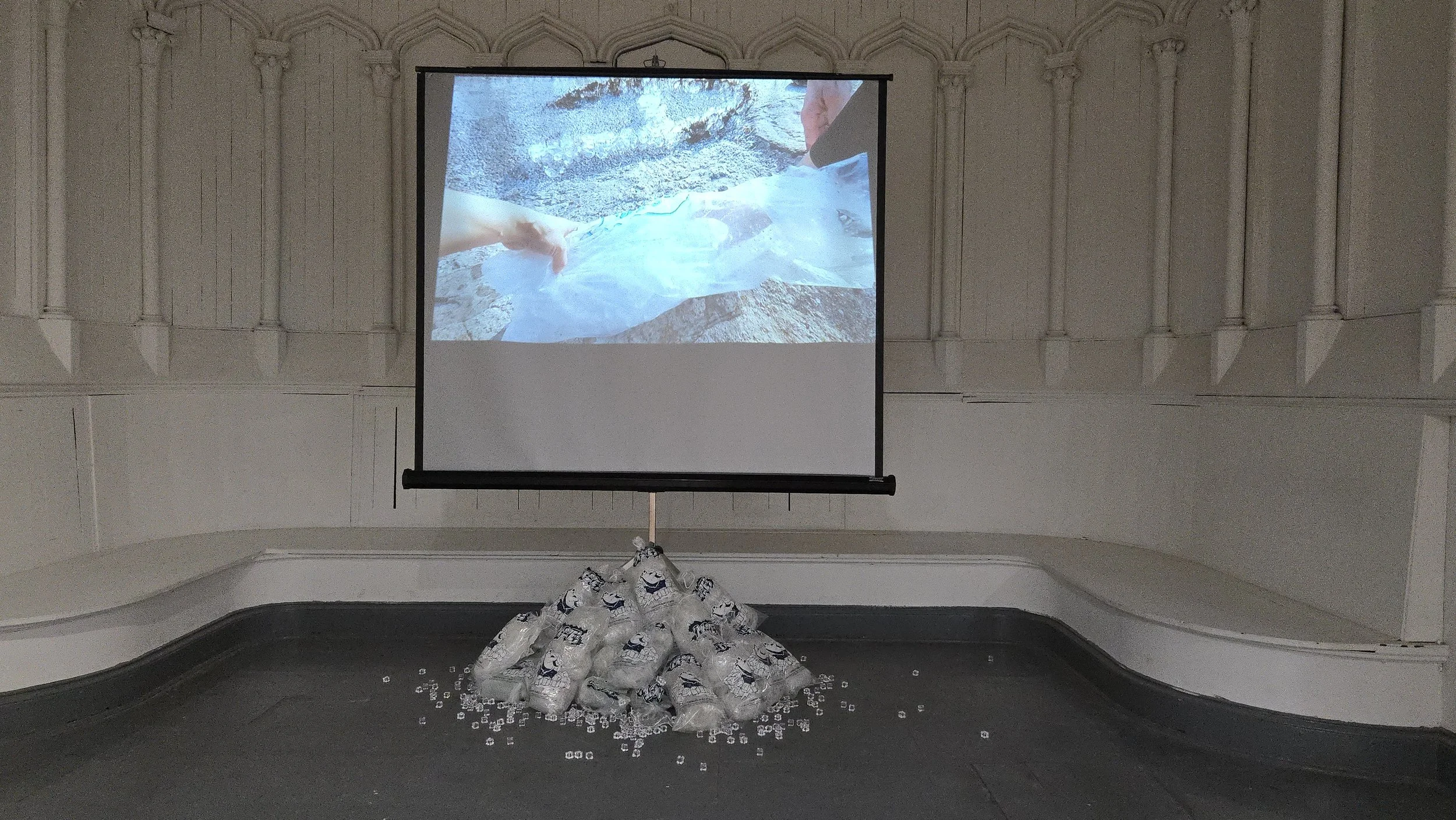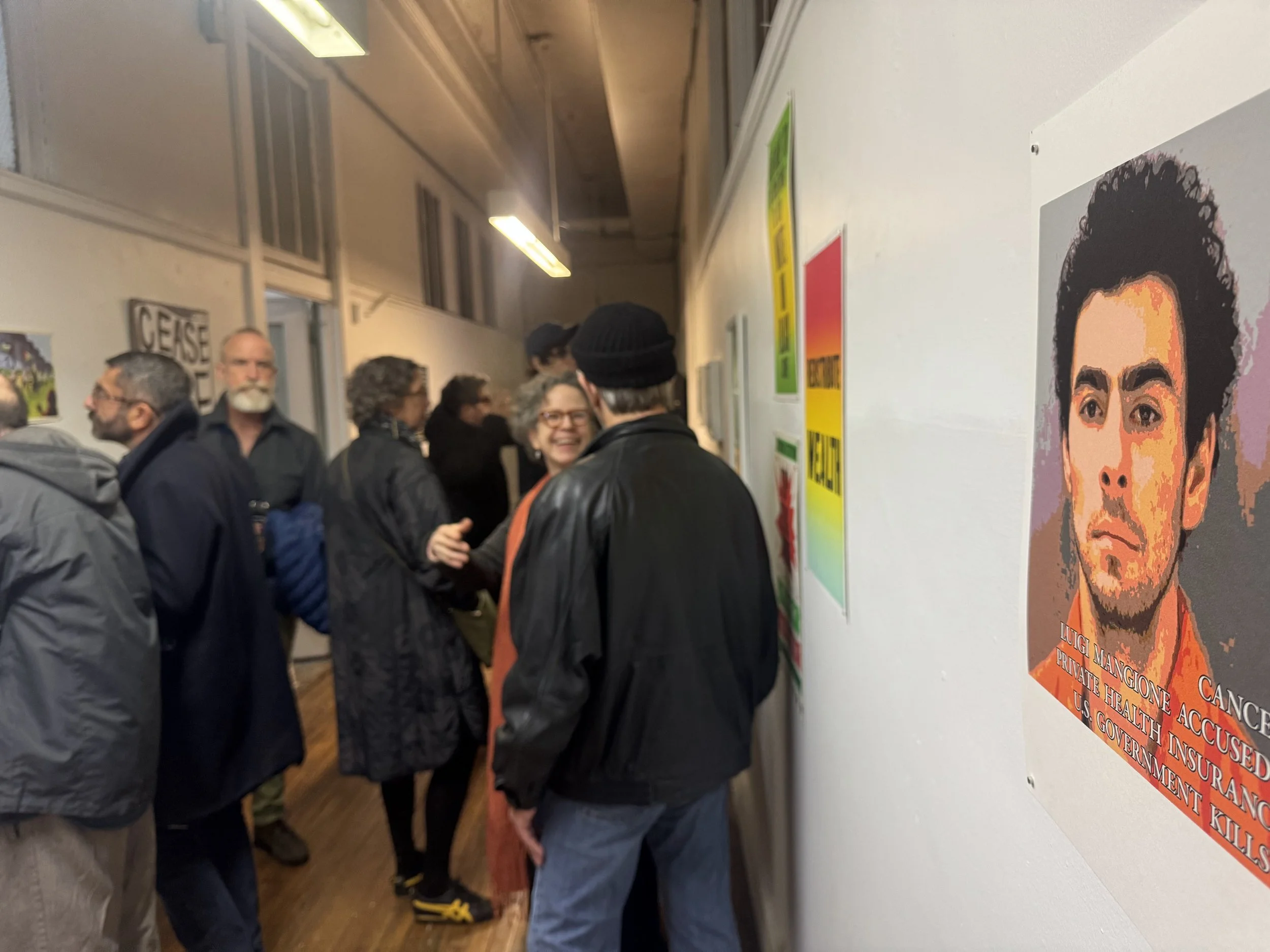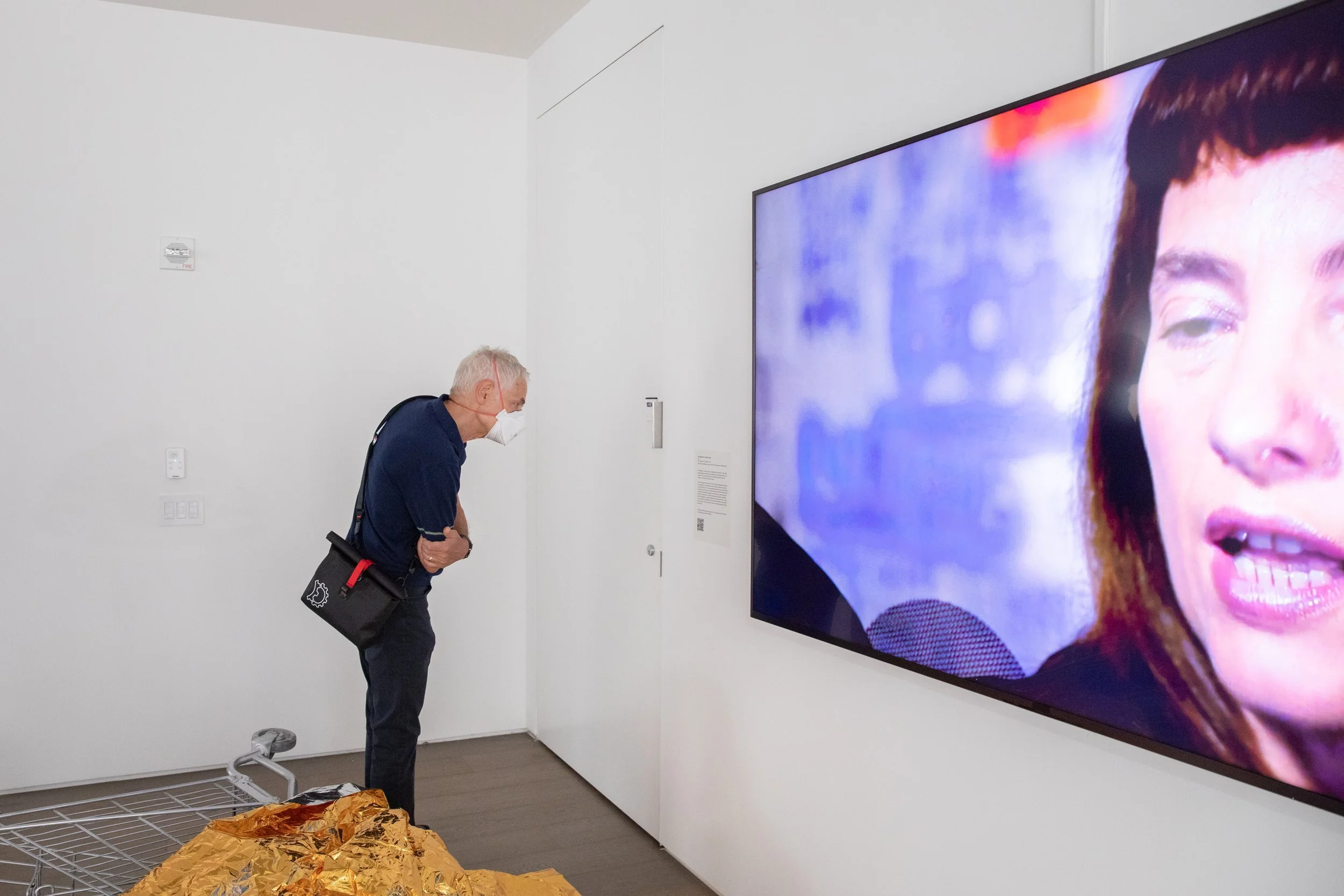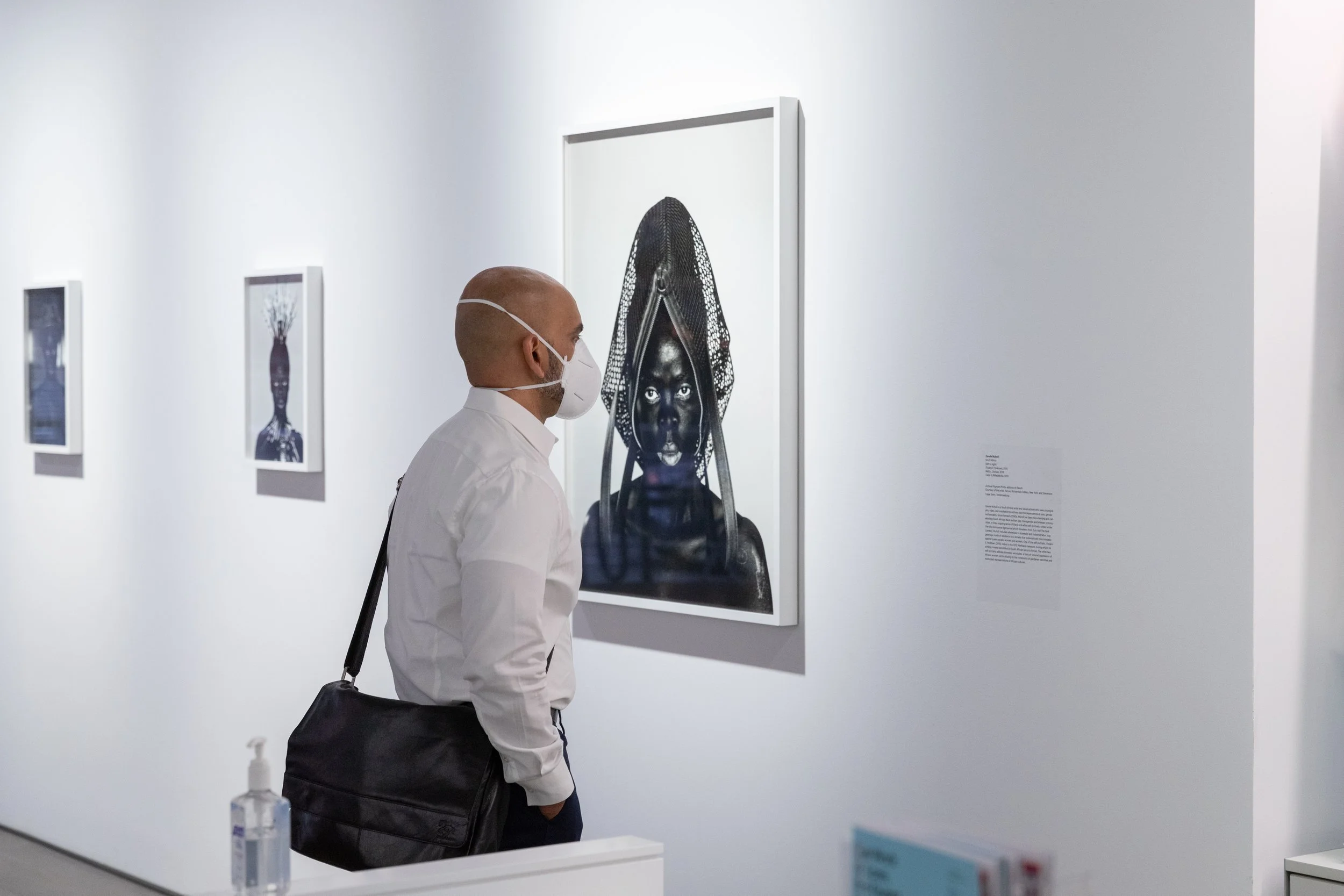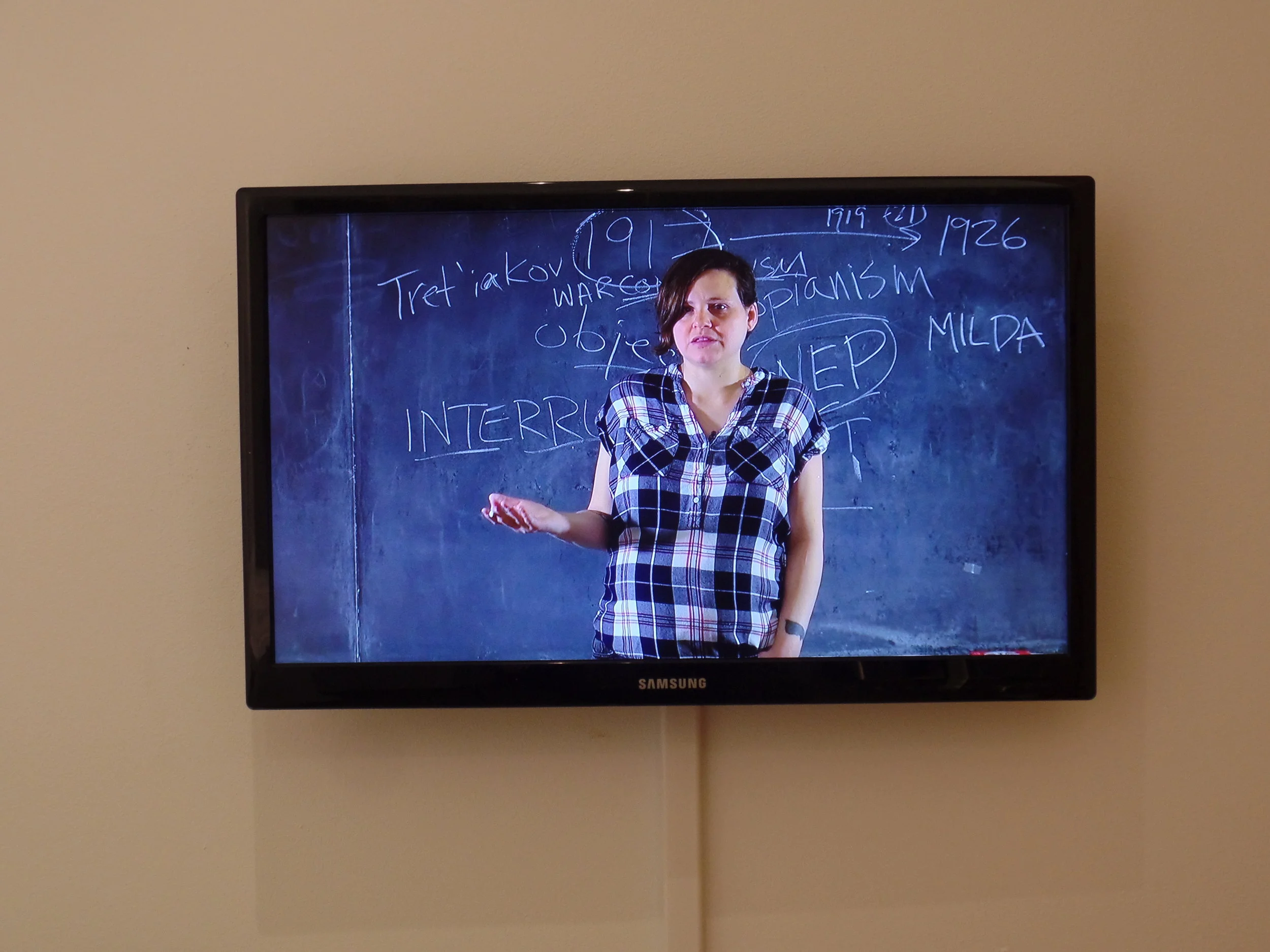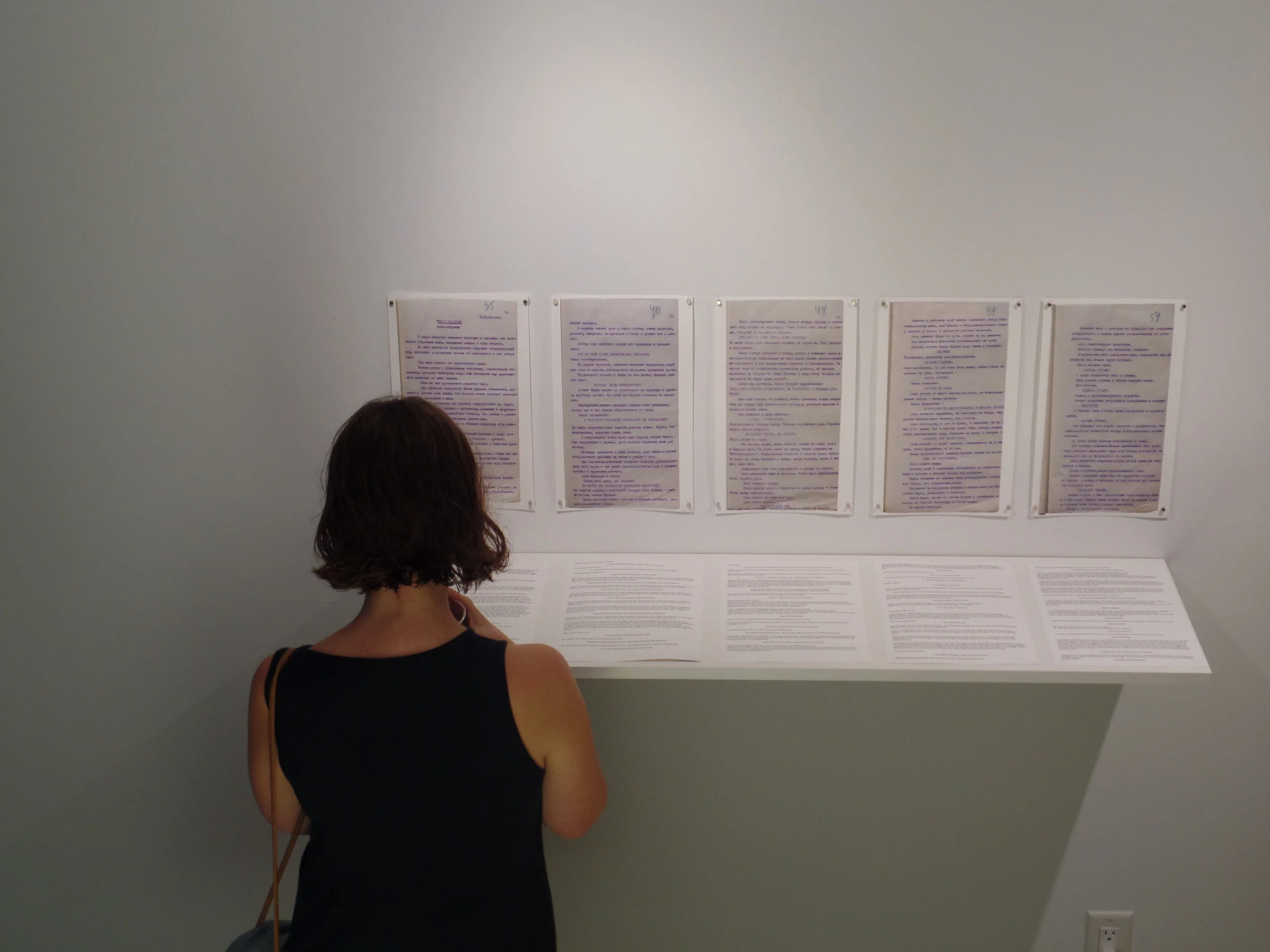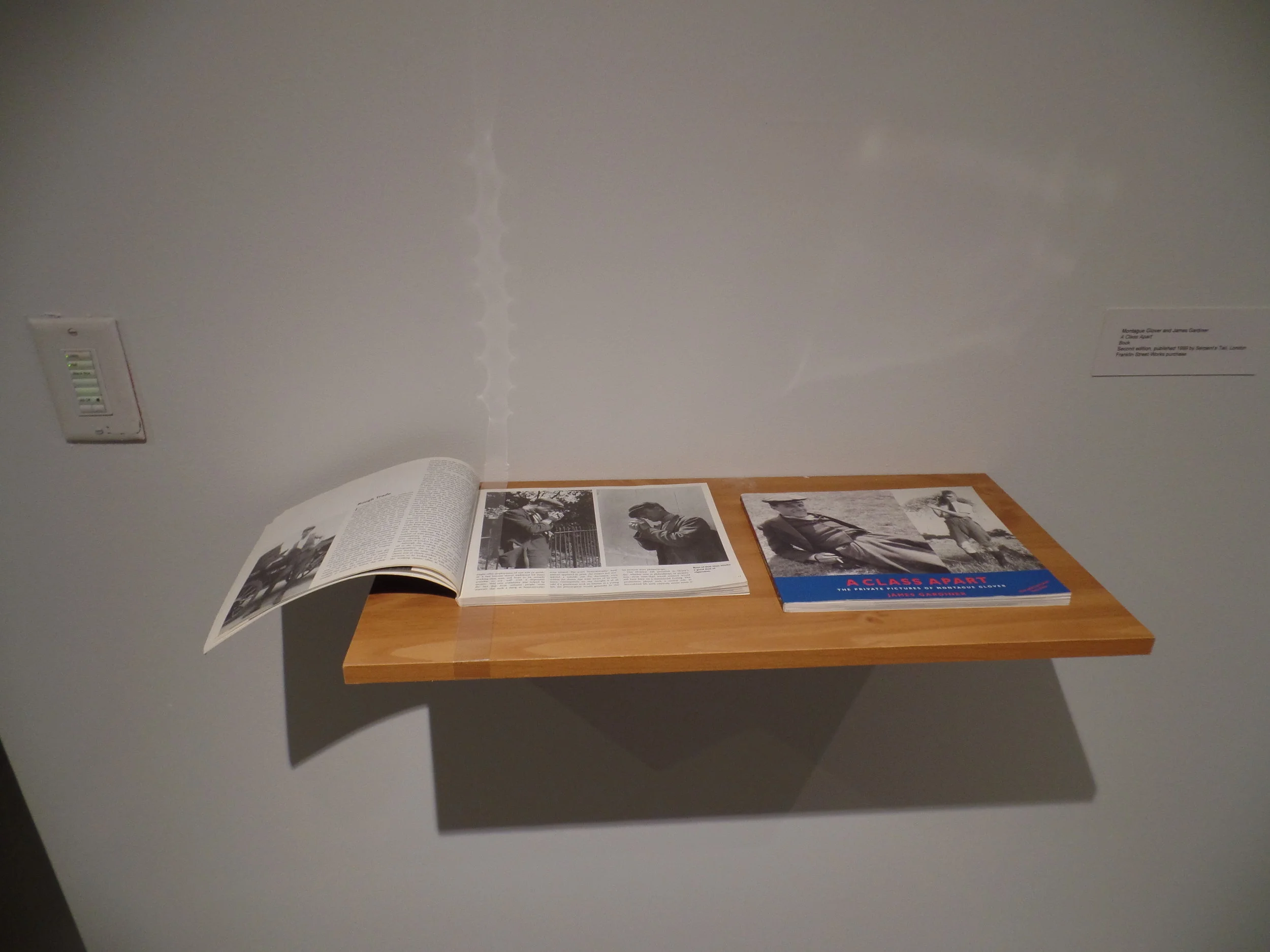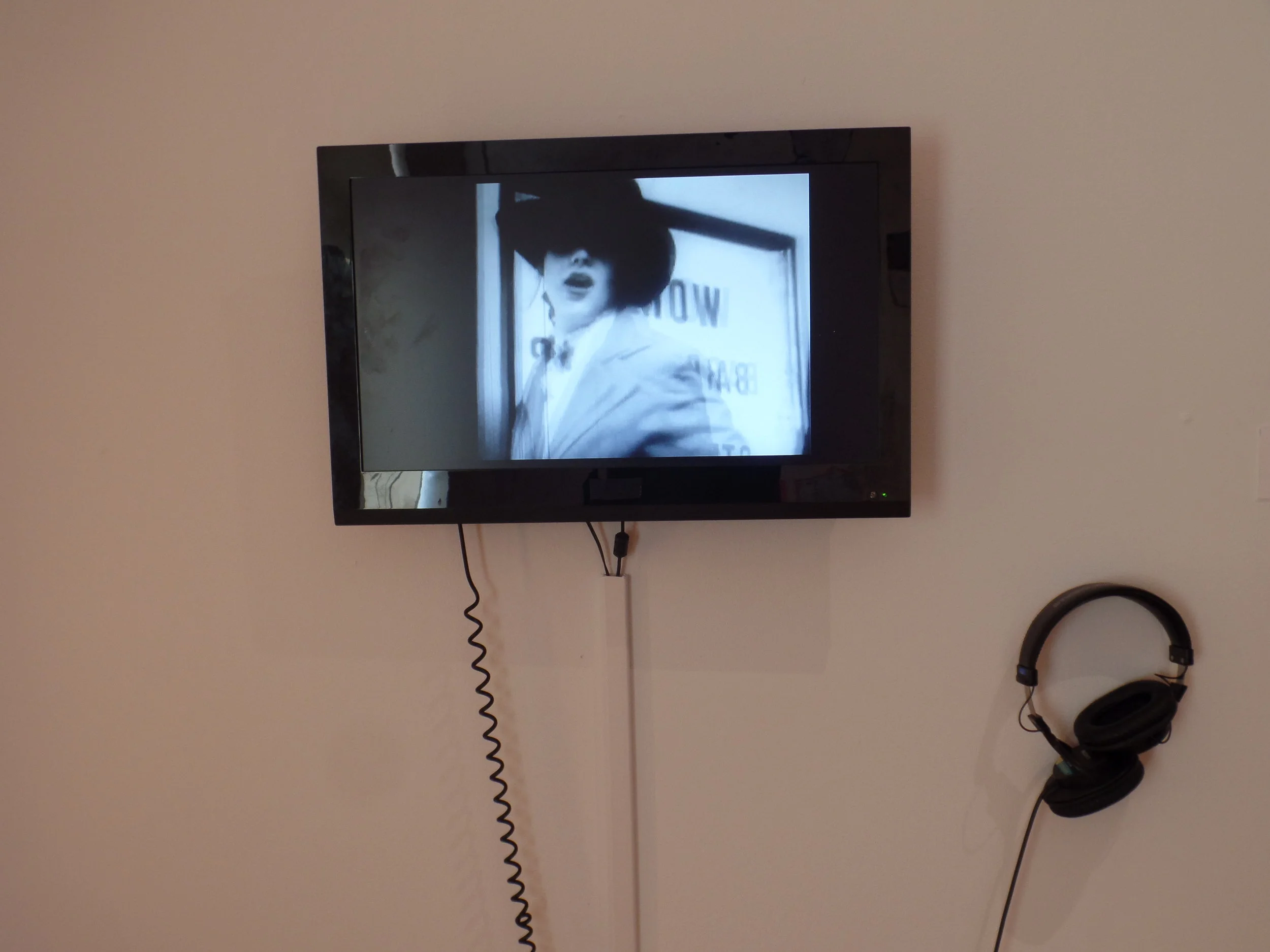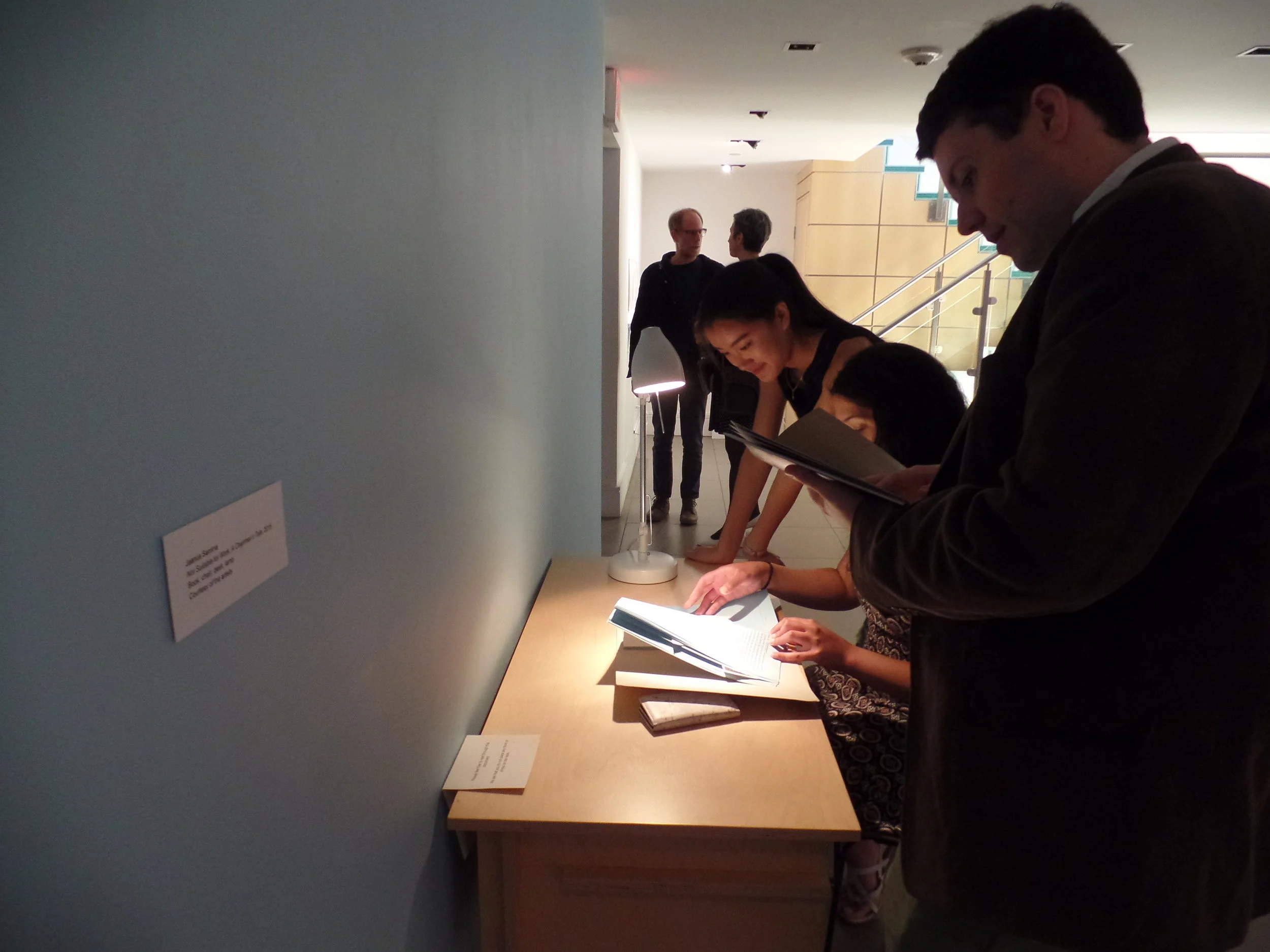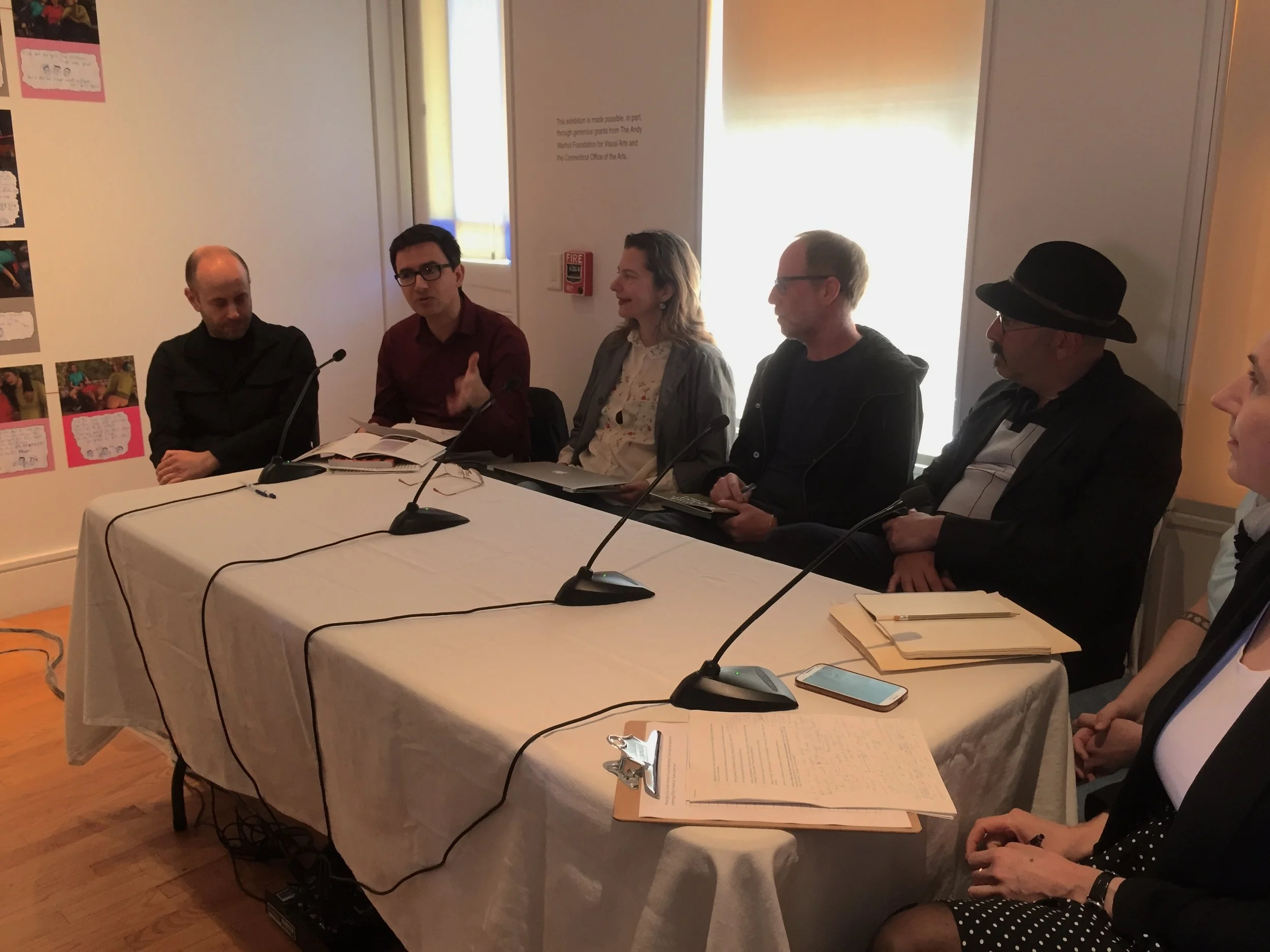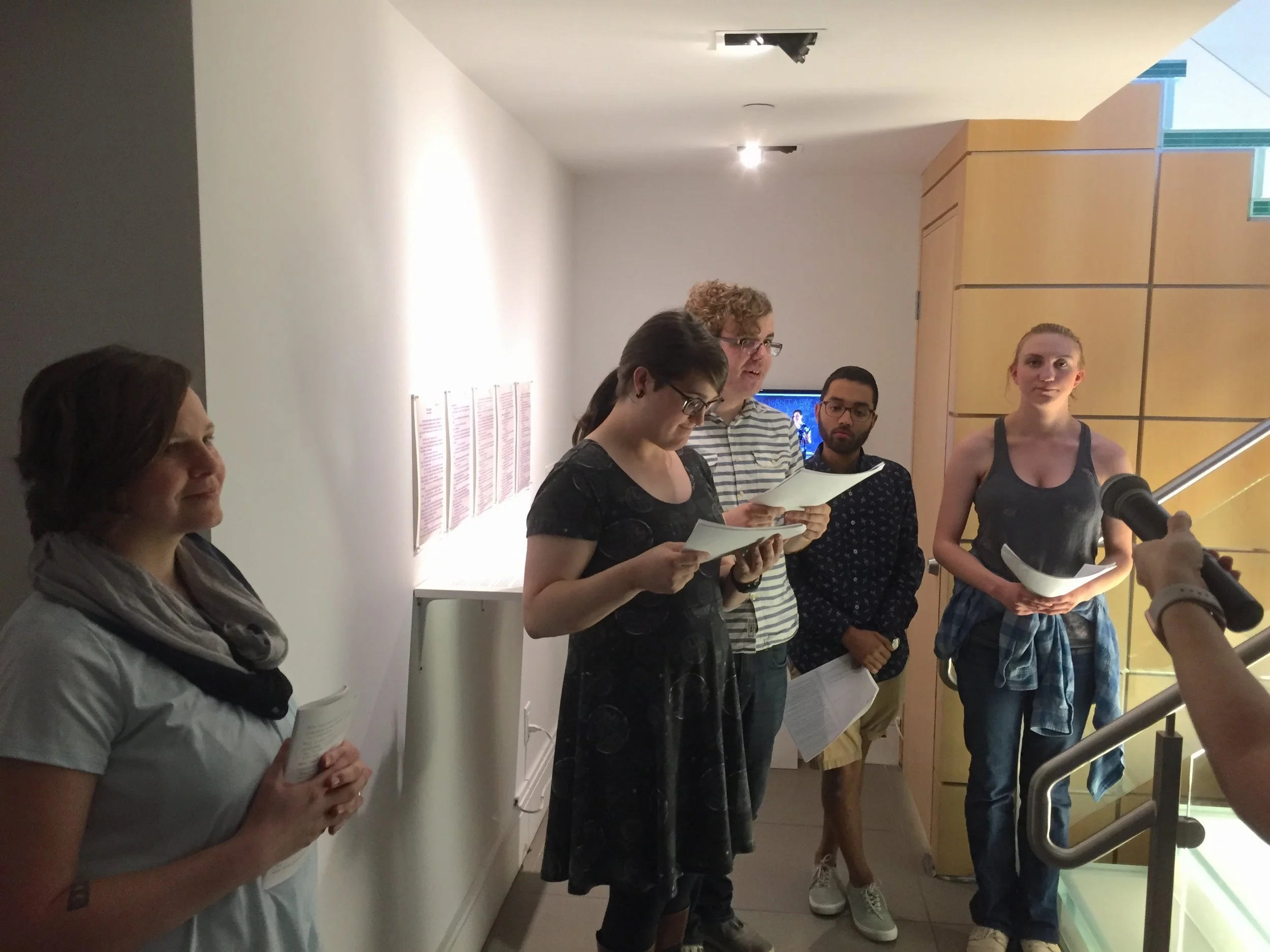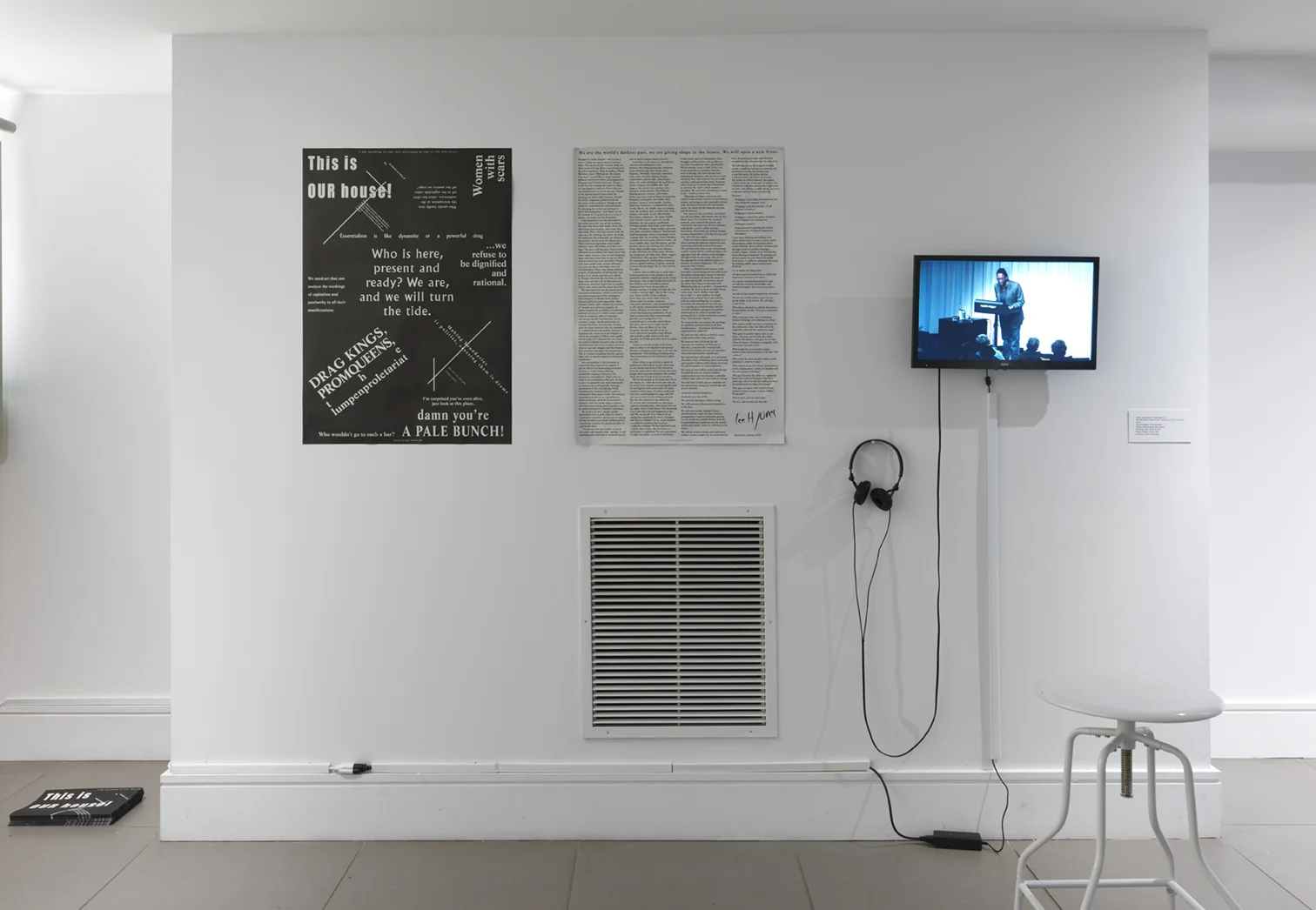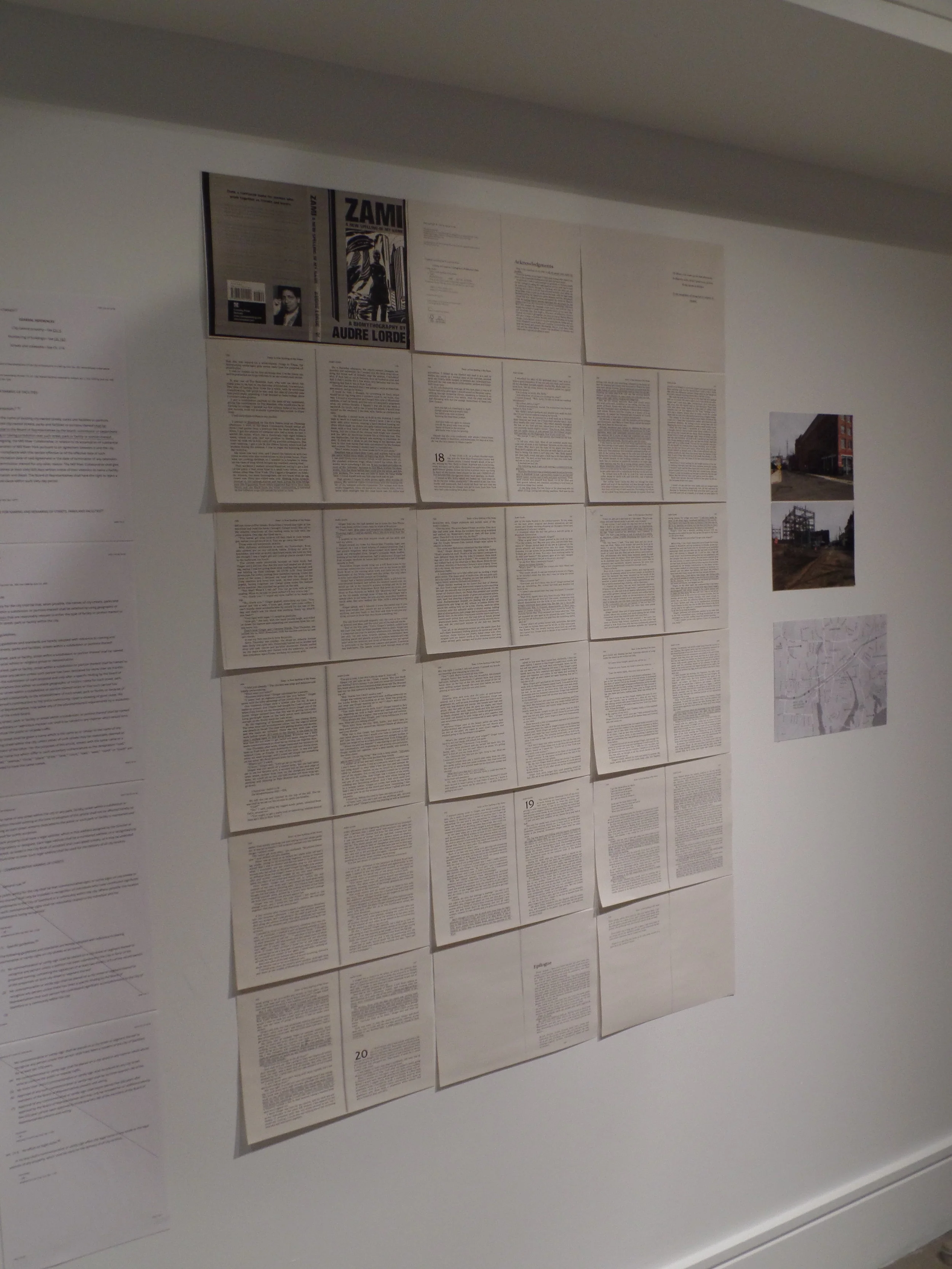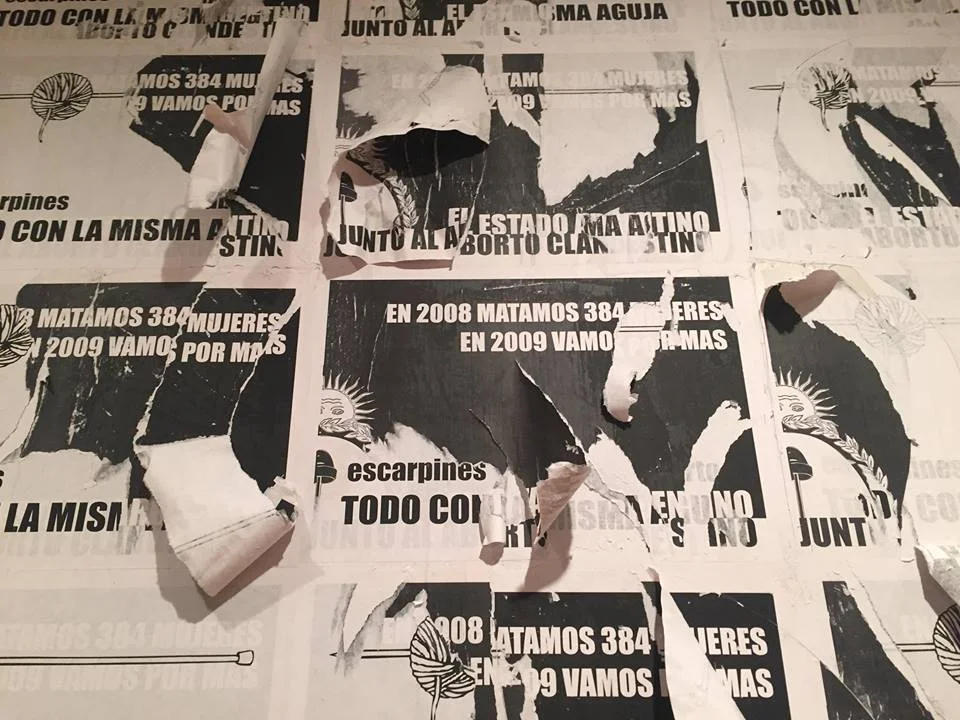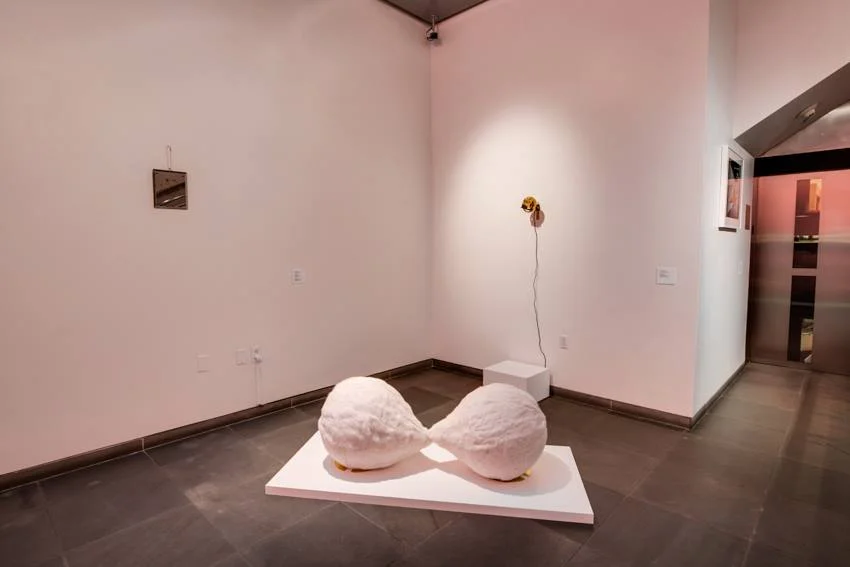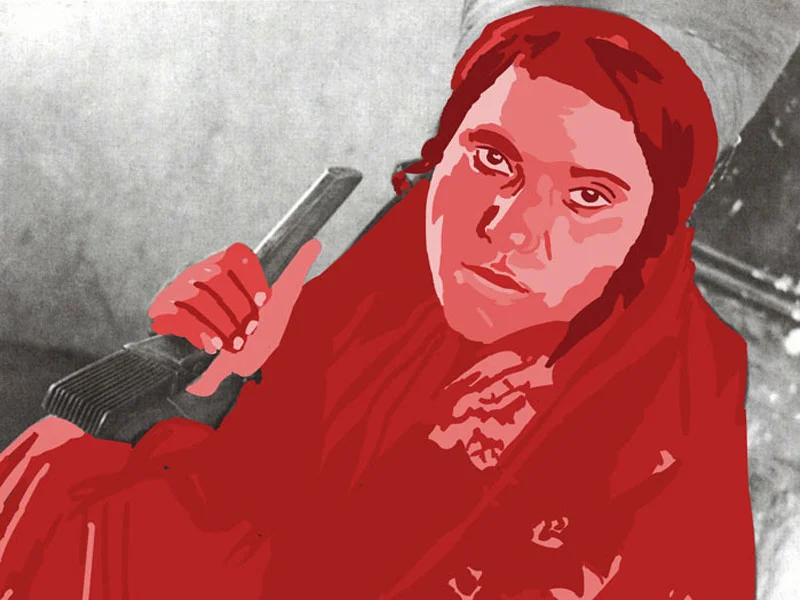Cancel This Show!
Photo: Installation view. Painting: Jerry Kearns, Slip Sliding Away, 2025.
Exhibition at The Clemente Soto Vélez Cultural and Education Center is organized in conjunction with Fall of Freedom
Address: 107 Suffolk St, New York, NY 10002
November 21- December 20, 2025
Curators: Olga Kopenkina/ Gregory Sholette
Participating artists: Todd Ayoung, Noah Fischer, Jerry Kearns, Dread Scott, Jenny Polak, Zoe Beloff, Seth Tobocman, Shellyne Rodriguez, Kiyo Gutierrez, Theodore Harris, Jim Costanzo, Yevgeniy Fiks, Molly Crabapple, Julian Phillips, and Josh McPhee.
At a time when journalists and comedians face "cancellation" for opposing MAGA culture and rising ultra-nationalism, where are the artists? "Cancel This Show!" critically examine xenophobia, urban militarization, and attacks on democratic institutions in the U.S.A. Drawing inspiration from historic activist exhibitions—from 1967's Angry Arts Week to Artists Call Against US Intervention—this pop-up exhibition challenges contemporary artists to reclaim their role as social critics. Through sharp commentary, humor, and parody, the works that span diverse formats—political posters, wall stencils, conceptual graphics, canvas painting, collage, photomontage and video—visualize current injustices while fostering dialogue about art's responsibility in times of political crisis.
A Life Worth Surviving For. Works of Oliver Ressler.
Exhibition at James Gallery, CUNY Graduate Center. Sept 13 – November 1, 2024.
Curator: Olga Kopenkina
The opening: September 12, 6 pm.
Public discussion with Oliver Ressler and Ashley Dawson, a writer, research and climate activist: Sept 13, 6 pm.
James Gallery at CUNY Graduate Center presents a collection of films and graphic works of Oliver Ressler, the renowned artist and social movements researcher, in his first-ever exhibition in the USA.
Since 2008, Austria-based Oliver Ressler has dedicated his art to exploring diverse activist approaches in response to the climate crisis that has pushed our world to the precipice of multiple catastrophic “tipping points.” These critical thresholds, once crossed, unleash colossal and often irreversible changes within our climate system. Climate activists around the world confront corporations producing fossil fuel, while demanding more action from their governments to curb carbon emissions. Ranging from poetic to documental, and often interventionist representations, Ressler’s works focus on communities and activist groups in Austria, Germany, Spain, and Ecuador, who resist construction projects and mining operation that cause destruction of natural forests, ancestral land, and water.
In many of his films, Ressler documents the assemblies and working group meetings of global climate activists – a mix that includes artists and poets. These dynamic gatherings serve as crucibles of discussion, where the participants deliberate on the methods and objectives that will guide their collective struggle for a future that transcends mere survival. Films “Barricade Cultures for the Future” and “Overturn the Present, Barricade the Future,” presented in the exhibition, feature activists with a background as artists and cultural workers questioning the widespread habit of treating “art” and “activism” as separate categories, when in practice, they often overlap and influence each other.
Ressler’s graphic works passionately advocate for immediate action. In the series of drawings titled “Contours of the Coming World,” presented in the exhibition, the artist intertwines his visionary depictions of everyday activities aimed at safeguarding the environment with the practices he has witnessed and actively engaged in alongside activists from around the globe. These illustrations serve as a bridge between his imaginative insights and the tangible realities of environmental activism.
The Work of Love, the Queer of Labor
Pratt Manhattan Gallery
June 23 - August 20, 2022
Artists: Angela Beallor, Dyke Action Machine (DAM!), Yevgeniy Fiks, Hugo Gellert, Noam Gonick, Hagra, German Lavrovsky, William E. Jones, Erik Moskowitz+Amanda Trager, Zanele Muholi, Jaanus Samma, Aliza Shvartz, Werker Collective, and YES! Association / Föreningen JA!.
The exhibition featured Harry Hay papers from One National Gay and Lesbian Archive and the poster “Come Out!! (Gay Liberation Front and Peter Hujar).
Franklin Street Works, Stamford, CT
May 21st - through August 27th, 2017
Co-curated with artist Yevgeniy Fiks. Works by Angela Beallor, Hugo Gellert, Montague Glover, Noam Gonick, Hagra, William E. Jones, Erik Moskowitz+Amanda Trager, Jaanus Samma, and YES! Association / Föreningen JA!.
Two iterations of the exhibition The Work of Love, the Queer of Labor” featured graphical works, photography, video, posters, and installations that explore both historical and imagined connections between queer and left activisms. By reviewing queer identities from the class perspective and class identities through queer sensibilities the artists in the show rediscover progressive potential within today’s LGBTQI cultural paradigm. The exhibition also links today’s queer activism to the historic belief among some earlier gay and lesbian rights activists, such as American gay rights activist Harry Hay, that by liberating both love and labor people can build a self-regulating worker’s society, as opposed to one that exploits and commodifies sexual bodies. Coming from diverse geographic locations and historical backgrounds, the artists in the show reflect upon past utopias –– from Russian revolutionary “queer” avant-garde projects, international working-class movement, to classless “affectionate communities” built on gay and lesbian solidarity. While evoking the spirit of past revolutions and protests, the exhibition envisions new forms of social organization and sustainable life, opposed to the “spirit” of automated digital capitalism and social polarization.
"Emergency Turned Upside-Down"
Screening of films by Oliver Ressler at UnionDocs.
May 4th, 2017
Screening was followed by discussion between Oliver Ressler and Yates MacKee, moderated by Olga Kopenkina.
Oliver Ressler is a Vienna-based artist and filmmaker, who produces installations, projects in public space, and films on issues such as economics, democracy, global warming, forms of resistance and social alternatives.
Two new works by Oliver Ressler refer to the migration and flight that war and conflict in Syria (and other states) have set in motion. The questions the films pose are: Can European politics be analyzed from the point of view of Syrian refugees? In our debate on borders, migration, and refugees, how do we use the word “emergency”? Do refugees create “the state of emergency,” when crossing national borders, or it’s governments policies that put the world on the edge?
Program:
Emergency Turned Upside-Down, by Oliver Ressler, 2016, Austria, 16 min
There Are No Syrian Refugees In Turkey by Oliver Ressler, 2016, Austria/Turkey, 30 min
"Feminism is Politics!"
Pratt Manhattan Gallery, New York.
September 16th - through November 23rd, 2016.
Feminism Is Politics! is an inquiry into what is conceptualized by feminists and queer/lesbians in the 21st century as New Feminism. The exhibition features installation, video, graphics and performance works that address the feminist position in action and redefine the notion of “political” within the new millennium's paradigm of uncertainty and precarity.
afterimage review - vol.44,No.4 - Jan./Feb. 2017
Artists:
Pauline Boudry/Renate Lorenz, Bureau of Melodramatic Research, Melanie Cervantes, Regina José Galindo, Natalia Pershina-Yakimanskaya (aka GluklyaVictoria Lomasko, Liza Morozova, Mujeres Públicas, Tanja Ostojic, YES! Association / Föreningen JA!, Anna Zvyagintseva
Panel Discussion was moderated by Martha Wilson, the Founding Director of Franklin Furnace, with panelists Olga Kopenkina, Tanja Ostojic, and Mujeres Públicas.
Performance by Tanja Ostojic entitled “Misplaced Women?” followed the panel discussion.
This exhibition is sponsored in part by the Republic of Serbia Ministry of Culture, the Berlin Senate Chancellery-Cultural Affairs Department, and the Swedish Arts Grants Committee’s International Programme for Visual and Applied Artists.
Film program “Feminism is politics!”
Beursschouwburg in Brussels, November 21st, 2013. Organized by Kopenkina during her ten-days research residency with KRAN Film collective in Brussels, Belgium.
The program included the following films:
“Female President” by Lana Cmajcanin
“Female Fist” by Kasja Dahlberg
“Protect Your Heart at Work” by The Bureau of Melodramatic Research
“Punk Prayer” by Pussy Riot
“Locusts” by Iqaa The Olivetone
“Attica” by Manon de Boer
From the press-release: “The program is a contribution to the discussion about relationship between art and politics, revealing the diversity of feminist practices in construction of oppositional identity in the age of global activists’ internet-based networking and organizing. The works in program particularly stresses the significance of organized action through the use of media (contemporary internet media as opposed to the early independent TV stations and pirate radio) in countries from Bosnia to USA, which endure socio-economic transformation. Feminist is Politics! embraces the wide spectrum of art and activism: from performance and video to direct actions, redefining notions of “riot”, revolt, autonomy, emancipation, revolution, and other concepts that shape New Feminist philosophy.”
In February 2014, Olga Kopenkina co-chaired, together with Corina Apostol, panel “Riots, No Diets: Construction of Oppositional Identity in Feminist Activist Art” at College Art Association’s 102nd Annual Conference, Chicago.
"Future Queer Perfect"
Station Independent Project, NYC
December 17th, 2015 - through January 3rd, 2016
Co-curated with Yevgeniy Fiks
Artists: Cary Cronenwett, Yevgeniy Fiks, School of Theory and Activism, Bishkek, STAB
***MENTIONED AS ONE OF THE BEST SHOWS OF 2016 AT THE WALKER ART CENTER WEBSITE: https://walkerart.org/magazine/2016-the-year-according-to-zach-blas
Drawing on José Esteban Muñoz's assertion that "queerness's form is utopian," exhibition Future Queer Perfect explores utopian dimension of queer imagination and memory. The artists in the show share a "queer gaze" on the past, reanimating the gestures, events, and cultural products in order to revisit the legacies of utopianism, political Left, and Soviet Union's socialism, with a hope for a new inclusive sociality. Embodying, inserting itself into, or appropriating the moments or artifacts from the past, the artists retroactively extend and broaden the utopian not only to accommodate the queerness of the present, but also to posit it as an integral part of a possible futurity.
In Cary Cronenwett's Maggots and Men, the viewer sees a reenactment of the Kronstadt sailors' rebellion in the post-revolutionary Russia in 1921, "with a twist of gender anarchy," effectively queering the early avant-garde Soviet cinema and suggesting a gender revolution that remained unfulfilled by the October.
Yevgeniy Fiks' Toward a Portfolio of Woodcuts (Harry Hay) narrates about contradictions of being communist and gay in the 1930s-1940s America and the beginning of the gay rights activism in the 1950s, via quotes from the communist and founder of the modern gay rights movement in the United States, Harry Hay, revealing the early political split within the gay rights movement in the United States between radicalism and assimilation.
Queer in Space: Kollontai Commune in Frunze of the 1970s by School of Theory and Activism, Bishkek (STAB) makes a historical intervention with the archive of the Kollontai commune, a queer communist collective associated with the architecture school in Frunze (now Bishkek) in the 1970s, radically revising our conception of the political and gender dissident in the late Soviet Union.
"LENIN: ICEBREAKER REVISITED"
Austrian Cultural Forum NY
+++ VOTED ARTFORUM CRITICS' PICK. READ HERE+++
December 11, 2014 - March 9, 2015
ARTISTS:
AMY BALKIN, JUDITH FEGERL, YEVGENIY FIKS, JIM FINN, LISA KERESZI, MARKO LULIĆ, LISI RASKIN, ISA ROSENBERGER, LEONID TISHKOV
Press-release:
"Lenin: Icebreaker Revisited" is based on "Lenin: Icebreaker", a special exhibition which was organized by the Austrian Cultural Forum Moscow, the LENTOS Kunstmuseum Linz, and Rosatomflot and presented at the 2013 Moscow Biennale of Contemporary Art. It was curated by Simon Mraz and Stella Rollig, and included exhibitions on the icebreaker Lenin in Murmansk, Russia (09/18/2013–01/10/2014) and at LENTOS Museum in Linz, Austria (2/28–05/25/2014). Curator Olga Kopenkina has revisited the exhibition for the Austrian Cultural Forum New York by including American artists.
In 1957 the Soviet Union launched the icebreaker Lenin to international fanfare which included delegations from the United States and United Kingdom. As the world’s first nuclear-powered civilian vessel it epitomized the “Soviet Peaceful Atom” initiative, which promoted the application of atomic energy for purposes of civil engineering – a program epitomized in the opening of the world’s first nuclear power plant in 1954 and the Chernobyl disaster some thirty years later. The Lenin would operate for 30 years before being decommissioned to serve as a floating museum, its hull worn too thin by decades’ worth of ice to continue operation.
In its youth, the icebreaker Lenin served as an icon of the socialist utopian ideal: a classless society based on boundless technological progress through the lens of military advancement and limitless resources through the application of atomic power. In the world that has emerged in the ensuing years, in which a tiny portion of the world’s population receives limitless services in an automated, computerized, late-capitalist utopia amidst a steadily degrading ecology and decentralized global strife, the exhibition "Lenin: Icebreaker Revisited" posits the question: Does utopia still have a social function?
Amy Balkin’s ongoing project, A People’s Archive of Sinking and Melting, displays objects found in areas experiencing rising sea levels or land erosion, and includes a Russian contribution.
Three works by Judith Fegerl examine the navigation of temporal and spatial reality and myth by way of sound and sculpture.
Drawings and sculptures by Leonid Tishkov show deep-sea divers as a metaphor for the “forgotten utopia” as the early Soviet avant-garde envisioned it.
Conversely, the abandoned and seemingly obsolete appears in American Lisa Kereszi’s Governors Island series of photographs depicting the island’s current state after decades of serving as a military site.
A slide projection and videos by Lisi Raskin show images of human-made environments and landscapes in Lithuania and Afghanistan, marred by Soviet construction, in an installation modeled on an American living room.
An installation by Yevgeniy Fiks features images of locations in Moscow named after revolutionary leaders, which between the 1940s and 1980s served as secret meeting points for gay people.
These photographs are directly attached to the volumes of Vladimir Lenin’s writings, translated and published by the American Communist Party.
A recent film by Austrian artist Isa Rosenberger tells the fictional story of a Soviet naval officer who immigrates to America amidst an eternal afterlife debate between Nixon and Khrushchev.
Jim Finn’s film Encounters with your Inner Trotsky Child constructs the "utopia" of personal salvation using a language that combines hyperbolic Communist rhetoric, lo-fi video effects, and a 1980s’ aerobics video.
Another video work, Marko Lulić’s Sacrifice, documents a modern choreography which pays tribute to Stravinsky’s seminal ballet piece The Rite of Spring, the conclusion of which serves as the starting point of a journey toward a better future.
"Sound of Silence: Art During Dictatorship"
EFA Project Space, NY
January 22 - March 10, 2012.
Artists:
antibrainwash.net
group FAU
Nikita Kadan
Alexander Komarov
Denis Limonov (Lime Blossom)
Marina Naprushkina
Ales Pushkin
Sergey Shabohin
Yauheni Shadko
Lena Soulkovskaia
Oleg Yushko
Curator: Olga Kopenkina
Curated by Olga Kopenkina, the exhibition brought together nine of the most active Belarus artists and collectives, and their videos, posters, paintings and installations created in solidarity with popular protests.
Belarus President Lukashenka usurped governmental control seventeen years ago, and proceeded to turn Belarus, once culturally vibrant and working to reestablish its national identity, into a repressive and stagnant dictatorship. In December, 2010, accusations against falsified presidential elections brought rise to a wave of peaceful protests throughout the country, which were, in turn unmercifully retaliated against by police and government forces.
Artists in Belarus began participating in the fast growing protest movement with new and bold actions that gained recognition throughout Europe despite the government’s efforts to silence them. Today, many of these artists, who came of age under the dictatorship of Lukashenka, use their practice to challenge the
status quo and contribute to the democratic movement, which expands far beyond the native land.
Sound of Silence was the first exhibition in New York City to survey the recent and powerful activities coming from this generation of Belarusian artists. It presents a range of installation, documentation and objects: from work generated by the collective www.antibrainwash.net, an artist-run activist website which features radical protest posters and materials that can be downloaded, printed and distributed; to Marina Naprushkina’s constantly morphing installation “The Office of Anti-Propaganda,” which presents images, objects, slogans and video footage exploring the illusory reality the Belarus government created through
public campaign; to documentation of Ales Pushkin’s outlandish staged performance confronting the cultural and political establishment that led him to immediate and constant arrest; to the Minsk-based group FAU’s “Monopoly: The Belarusian Edition”, addressing the dominance of economics over politics and culture, and allows game participants to assume the roles of government officials and win based on level of corruption; to Yauheni Shadko’s expressionistic narrative paintings of recent political events.
Sound of Silence was accompanied by a panel discussion organized by the Polish Cultural Institute and curator Olga Kopenkina. Participants include artist Sergey Shabohin (Minsk, Belarus), curator Olga Kopenkina (New York), philosopher and cultural critic Nelly Bekus (Warsaw), and President of Youth Section of Belarusain-American Association Tatsiana Kulakevich (New York). Critic and President of AICA, Marek Bartelik, will moderate the panel.
EFA Project Space, a program of the Elizabeth Foundation for the Arts, was launched in September 2008 with a focus on the investigation of the creative process, aiming to provide dynamic exchanges between artists, cultural workers, and the public. The Project Space presents exhibitions and programs in collaboration with a diverse range of organizations, curators and artists to provide a comprehensive and critical perspective on creative practices. A major aspect of the program's development is ongoing outreach to the myriad individuals and institutions effectively shaping culture today.
"Russia: Significant Other"
Anna Akhmatova Museum at the Fontanniy Dom, St. Petersburg, Russia
February 8 - March 3, 2006
Artists:
Mark Boswell (US)
Dimitri Devyatkin (US)
Jim Finn (US)
Jacqueline Goss (US)
Susan Kelly (Ireland)
Matts Leiderstam (Sweden),
Carlos Motta (US/ Colombia)
neuroTransmitter (Angel Nevarez +Valerie Tevere, US)
Nam June Paik (US)
Ricardo Zuniga (Nicaragua/US)
From the curatorial essay:
“Perhaps among all the aspects of the post-Soviet world, the Communist utopia remains one of the most privileged that has defined the Western subconscious. The West was able to absorb the Communist utopia in its “Leninist” version, and today, the elements of this utopia are reworked and planted into the fabric of both mainstream political discourses (especially in Western Europe) and popular culture here. In the 1990s and 2000s, the departure of the functioning communist utopia that is the Soviet Union gave way to nostalgia -- a nostalgia that does not discriminate. It is experienced not only by the post-Soviet subjects from Eastern Europe, but also by Westerners. As the East occupied a privileged place in the collective conscience of the West, the departure of the Second World was felt by Westerners rather strongly.
Moreover, today "Russia" seems to extend far beyond the country's national borders. It exists in the West, as if finally manifesting the success of the Soviet Union’s propaganda machine in winning the hearts and minds of Western intelligentsia. In the 2000s, the word "Russia" became an empty container, which can be successfully mobilized by different subjectivities. One can argue that even today, Russia becomes an imagined community, a community of people in Russia, the West, and elsewhere, whose political unconscious is connected to Russia, or what it represented and/or still represents.
Works in exhibition Russia: Significant Other deal with political utopias, myths and traditions, which bound Russia and the West in different times of the history. They do not necessarily address the realities of Russia, or its history, but they introduce the models of connecting with Russia as the Other - through their own personal experiences, stories and investigations.”
"Post-Diasporas: Voyages and Missions"
Moscow Museum of Contemporary Art, Russia
January 29 - February 26, 2005
The exhibition, organized in frameworks of 1 Moscow Biennale of contemporary art at Moscow Museum of Contemporary Art, focused on strategies of cultural identification in the works of the artists who have lived in immigration, with its characteristic contradictions between a voluntary assimilation and cultural self-isolation. The artists, once émigré from Eastern Europe living in the West, navigate between various cultures interrogating the boundaries between “foreign” and “one’s own”.
Artists: Alina and Jeff Bliumis (Belarus/Moldova-USA), Daniel Bozhkov (Bulgaria-USA), Pavel Braila (Moldova – Holland), Yuriy Gavrilenko (Russia-USA), Anton Ginzburg (Russia-USA), Olga Kisseleva (Russia-France), Anna Kowalska (Poland – Austria), Joanna Malinowska (Poland-USA), Yaroslav Mogutin (Russia – USA), Sviatoslav Solgannik (Russia-USA), Yevgeniy Fiks (Russia-USA).
In discussions about globalization, the issue of identity seems to be resolved once and for all: immigrant life in an alien context is defined by the promise of their inevitable integration into the common multicultural space of the globalizing world. However, what forces us to speak in different languages and build isolated societies – diasporas – within a single country? What is it that keeps us away from the voluntary assimilation, approved by the theory of “melting pot,” and forces us into the solitude of “other” culture, religion, or values? What makes unavoidable the division of cultures into “one’s own” and “other”? And which culture becomes “one’s own” and which is “other’s”?
From the outset of the Western civilization, identity politics places the concepts such as “immigrant,” “refugee,” “the exiled,” “pilgrim” into the same category of “foreigner.” Julia Kristeva, in her book “Strangers to Ourselves", considers the history of phenomenon of “foreigner” as parallel to the general development of the Western culture with its inherited perverseness that resulted in the inclusion of “a value and its opposite, the same and the other, the identical and its alien.” Precisely due to this perverseness of values, cultural vision is directed towards the “stranger.” Thus, the development of contemporary civilization always begins with the rejection of the foreign, then comes to its neutralization, and ends in “becoming a foreigner,” a stranger to itself. The development of contemporary civilization always begins with the rejection of the foreign, then comes to its neutralization, and ends in “becoming a foreigner,” a stranger to itself. “The romantic or terroristic seriousness of strangeness in itself becomes dissolved in the glittering of polymorphic culture that returns everyone to his or her otherness or foreign status.” (Kristeva)
The issue of the relations of diasporic subject to her/ his national culture and history is refracted in peculiar way in practices of those artists, who undertake a journey to the country of departure, combining both Gulliver’s encounter with “strange” societies and Ulysses’ anticipation of “cultural shock” in his comeback home. Anna Kowalska pursues this combination in her work Postcards from Warsaw. She juxtaposes two sets of photographs: one, the postcard-size, taken during her trip to native Warsaw, depicts realia of the Warsaw ghetto of the 1940s – something that turned out to be the setting built for Roman Polanski’s film “The Pianist” – and the second one that consists of the photographs she took two years after Polanski shot his film on the site of the former ghetto, the area that was already impacted by modern gentrification. The project painstakingly presents two directions in the evolution of post-socialist Polish identity: one is defined by the fragmented memory of the Warsaw Ghetto, the largest Jewish ghetto in the Nazi-occupied Europe, and another one is by the neoliberal plan of urban rejuvenation.
The theme of return is present in the three-channel video Barons’ Hills by Pavel Braila, which looks into modern Moldova, the artist’s motherland. The work shows the houses of gypsy “barons,” Moldavian Noveau Riche: eclectic, abundantly decorated facades and interiors of the gigantic mansions embody the essence of a diasporic subject-nomad which builds its own culture from the elements of “others’.
In Olga Kisseleva’s work Border, the artist points out to a “border” as a symbol of contemporary disintegration and alienation occurred inside the post-Soviet world which is opposed to the infinite freedom of an individual represented in the video by the sprint-dance of Keity Anjoure.
Alina and Jeff Blumis, in their pictorial series entitled geometric geography, generalize their experience of emigration associated with dramatic transition from the socialist, above-the-individual, reality into the context of other cultural and national identifications. In creation of this series, the artists used industrial materials and production processes, whereby provoking the conflict with work’s highly personal content.
In her work Untitled, Joanna Malinowska cleans New York residents’ apartments in exchanges for lectures on philosophy – an image of Polish emigre utilizing the stereotype of a Polish woman in Western consciousness. Another work of Malinowska, 22.56 square meters of “Karamazov Brothers.” Dedicated to Anna Grigorievna Dostoyevskaya, the writer's wife, who manually copied the Dostoyevski’s novel. The project revisits a national (Russian) culture in format of tedious, time-consuming action that is associated with the self-discipline and exercise in “faith."
Daniel Bozhkov not only emphasizes his Western-Slavic identity appealing to the cult of physical labor and connection to nature – the identity that hardly survived in the Soviet unifying models but successfully manages between the stereotypes in the cultural exchanges of the West and East – but he also reflects on the planting the Western consumer culture in the “eastern” soil. Bozhkov is more known for his work Be a Friend of Bacteria, in which he cultivated “lactobacillus bulgaricus” – a cultural-biological cliché of identity, ready to be vaccinated in “Western” body. In his new work, The Station of New Productivists, he explores the linguistic aspect of this problem: a video features two people reading the Swedish names of IKEAS products in Russian from the IKEA’s Russian catalog. The pathogens of “Western” culture represented by the Swedish furniture store, given a high number of IKEA stores in Moscow, made its way into Russian consumer culture and modified it from within. Another Bozhkov’s project in the exhibition is a documentation of the action during which the artist cut his own beard in front of the statue of Peter the Great in Moscow. The action is an artist’s commentary on Russia’s drastic transition from the appropriation of the foreign (Peter the Great’s reforms mandated Russian nobility to cut their beards and adjust their looks to European standards) to the hostility towards it (assuming that the beard could be an unalterable and comfortable part of a foreigner’s look.)
In his photographic works united under the title “No Love,” Yaroslav Mogutin confronts his own media image of “Russian Slava,” made by the Western mass media, with a narrative based on the real experience of extensive travels and intimate encounters, where the author persuasively avoids dealing with the fixed national identifications and appealing to the cultural cliché.
Assimilation-isolation dilemma is present in Anton Ginzburg’s work Totemdoppelganger. In a series of photographs and sculptures, Ginzburg depicts totems and signs of “other” diasporas (like Raiders, Latin-American football team from Oakland, California, and others) as well as mass-produced goods of the 2000s, such as ipod as a reference to immigrant’s cultural mimicry (in this case, with the Western modernist and postmodernist culture). From another hand, it reveals one’s parallel and exclusive existence as an alien within the “other” culture.
The exploration of the identity politics in the art of new media and activism connects individual reflections to the larger movements and radical tendencies in art that is reflected in video Hacker’s Cubicle by Yevgeniy Fiks. The author tries to position himself as a representative of the Russian diaspora in the West, drawing the parallels between Russian “hackers” and western artists-activists who intervene in the sphere of state and big business.
















